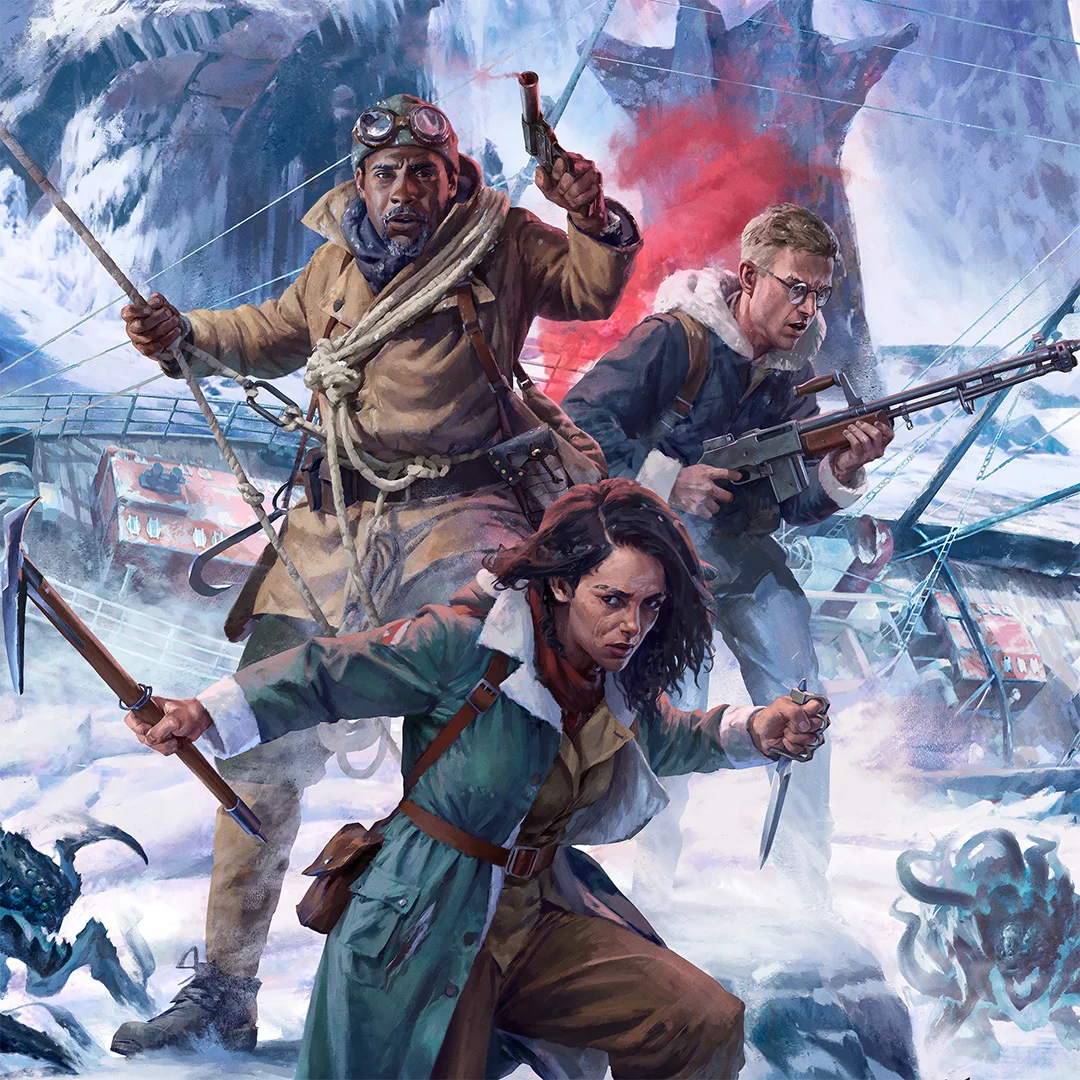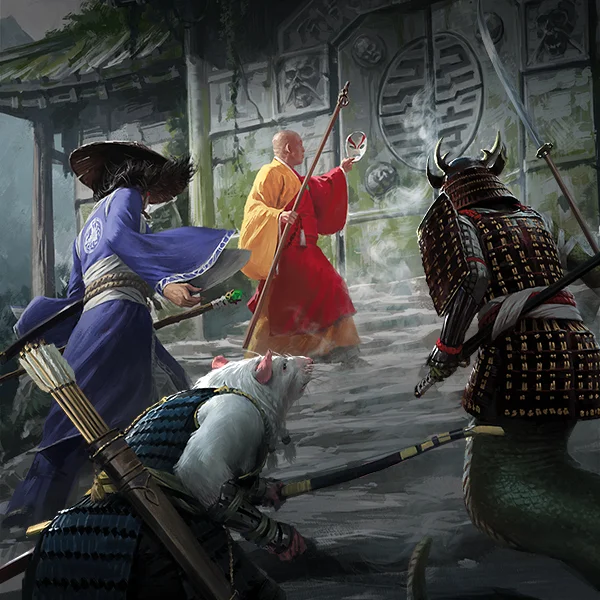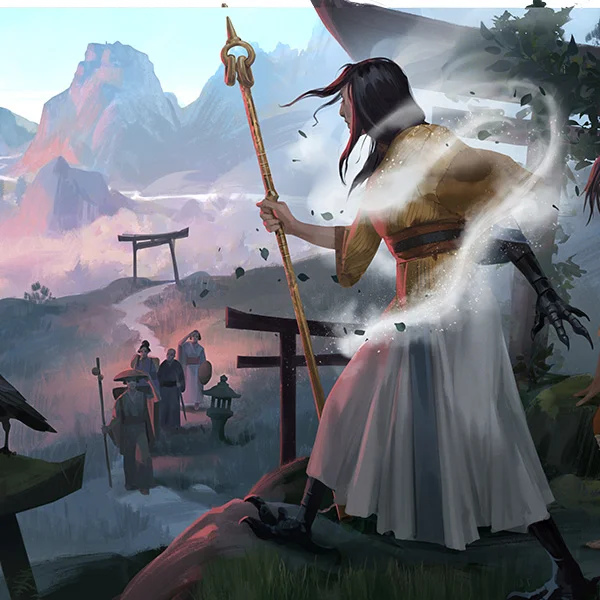The Making of the Tomb
2023 / 10 / 17
Hi everyone! My name is Lex Dykema and I was one of the developers who worked on Tomb of Iuchiban. I was a developer in the RPG department at Fantasy Flight Games before the pandemic working under Sam Gregor-Stewart on several IPs including Star WarsTM:The Roleplaying Game, Genesys (Android), and primarily on Legend of the Five Rings 5th edition. During the height of the pandemic I worked freelance for Asmodee NA and BrainCrack Games, but was eventually hired again by Sam as a full-time employee for Edge Studio at the start of 2022.
The process for making this campaign book was definitely an interesting logistical challenge and had started prior to my full-time status change. I fortunately was one of the initial freelancers to work on it during the early stages alongside Lydia Suen and Welden Bringhurst. Further along in the process, I also worked with Robert Denton III to create the initial introductory adventure in the City of Lies before players make their way to the tomb itself. You’ll hear from Robert about himself and his process later in this article.
At the start of the project we were pretty excited and had a lot of different ideas aimed at tapping into the best parts of the original 1998 box set of the same name published by Alderac Entertainment Group (AEG). We spent a lot of time trying to find a good balance between the different elements included in the book—we did our best to balance new player content, interesting lore, a meaningful first act before getting to the tomb, the tomb itself, and the finale.
We wrote a lot of content and did a lot of cutting, rewriting, and adjusting to try to strike the best balance between useful material for SRD system lovers, Legend of the Five Rings fans, those new to Adventures in Rokugan or even roleplaying games in general, and veteran gamers. It was definitely a challenge, but one I feel like resulted in a product that a wide range of folks can enjoy.
Let’s now focus on Robert Denton III, Lydia Suen and Welden Bringhurst and their work on the development of Tomb of Iuchiban.
Robert Denton III
Tell the readers who you are, your professional background, how you got into the game space, other products you’ve worked on that you’d like to highlight, and any other interesting or key notes about you as a person.
My name is Robert Denton III. I’m an author of fantasy, science fiction, horror, and tabletop roleplaying games.
I was introduced to Legend of the Five Rings—first through the roleplaying game, then eventuallythrough the card game—when I was in middle school and just getting into the films of Akira Kurosawa and Masaki Kobayashi. I think that would have been around 2001? The idea of a game that combined the fantasy stuff with which I was already familiar and the samurai dramas that I had just discovered… well it hooked me immediately. Samurai drama has transformed into a passion over the years and is a constant source of inspiration for me. As I studied cinema in college, I would return to that well time and time again.
My professional history with Legend of the Five Rings starts in 2011, when I joined the L5R Story Team under Alderac Entertainment Group. From 2011 to 2015, I wrote 60 short fictions set in the world of Rokugan, creating dozens of characters and working on several story prize fictions. During that time, I started the yearly tradition of the L5R Halloween horror stories, which continued later under Fantasy Flight Games. I wrote flavor text for hundreds of cards, resolved numerous story prizes, wrote entire chapters for the Legend of the Five Rings Roleplaying Game’s 4th Edition, and even led on several fiction projects. My sequential L5R detective series “Sins of the Father” influenced the way the Story Team approached storytelling near the end of our tenure.
After FFG acquired the franchise, I was recruited to contribute for the relaunch; “Risen from the Flames” was my first story for the relaunched L5R, and during my time I would go on to write approximately twenty fictions, two novellas (you can find them in The Great Clans of Rokugan volumes 1 and 2 from Aconyte books), and the capstone to the LCG storyline in “The Battle of Cherry Blossom Snow.” I also significantly contributed to the Legend of the Five Rings 5th edition line, and most recently for Adventures in Rokugan.
I also write some small, lofi-style roleplaying books for Gallant Knight Games. My most recent game, Tiny Taverns, is a gentle slice-of-life game about friends running a tavern in a fantasy setting that players invent as they play. My underwater fantasy setting “Destiny of Tides” portrays aquatic fantasy peoples who must venture into the ruined civilizations on land for treasures they can drag back into the deeps. I also wrote some horror games like Torn, where players physically tear pieces off their character sheet as they sustain injuries and endure terrors.
In addition to writing, I am also a graphic designer and layout artist for numerous games. But this section is already too long, so maybe I’ll talk about that at a later time (haha).
What is one of your favorite clans (major or minor)? What about that clan resonates with you?
It’s very hard to choose a favorite clan from L5R. When you write for the game, you must find something about each clan that hooks or fascinates you, because interest is what fuels writing. I love all the clans for different reasons.
If I’m being made to choose, I’ll go with the Sparrow Clan. They were my go-to clan for a long time in the roleplaying game. There are so many things I love about the Sparrow. I love that they’re a rural samurai clan who works alongside their commoners. I love that they’re dedicated to “honorable poverty.” I love that they use slings. I adore that their shtick is saying the honest and virtuous thing that nonetheless is a very bad idea to say — and that it always bites them in the butt when they do. Their clan identity is layered and their founding story is incredible. Most of all, I love the plucky-yet-stoic attitude they seem to embrace. They’re one of my favorite clans for my RPG characters to hail from. I get to act like a little sheep in the big city, be kind and sympathetic to commoners, AND still kick some butt as a samurai.
(Note from Lex: Robert had a few paragraphs here that were very well-written on the awesomeness of the Sparrow, but they had to be cut for space! Sorry again, Robert!)
But mostly, I feel like I can be a little goofy when I play a Sparrow in the RPG, or write for them as I did back in the AEG days. I didn’t even mind that the school was lower-powered than everyone else… that was by design! I love my little Sparrows. Now that’s a clan with moxie!
What aspects of Tomb of Iuchiban did you work on? What were your goals when setting out to work on each of those parts?
I wrote […] the precursor adventure […]. For this, I wrote out enemy profiles, fleshed out the City of Lies, and created some truly dark scenarios.
Adventures in Rokugan is, to my mind, fundamentally different than Legend of the Five Rings RPG. Whereas L5R 5e is a samurai drama simulator, with mechanics that facilitate that, AiR is a high adventure game and combat simulator, which naturally lends itself to different stories. […] I’m a “system matters” person; you’re choosing a toolkit, and the tools in that kit will determine what your system is better suited to do. Why play to weaknesses when one could play to strengths? With that in mind, I knew I couldn’t approach Tomb of Iuchiban with the same mindset I approach other L5R adventures. This one needed to invoke the D&D style of play, but without compromising what makes Rokugan so incredible and special. I hope players think I managed to do that.
One of my biggest goals was to present moral quandaries to players[…]. I wanted to ask the players, “just how far are you willing to go to do this?” AiR’s default assumption is that PCs are heroic — [but in this scenario, we don’t assume that]. So I didn’t want to give messaging that says, “the ends will always justify the means, as long as you’re sorry what you’re doing is okay.” I think that’s disingenuous and insulting to the player; I wanted to challenge them with actual tough choices that show a real cost to going about it this way.
At the same time, I didn’t want to force players to take any specific paths to accomplish their goals. I think the best scenarios are those where players are presented with a puzzle, but then have the autonomy to invent their own ways of defeating that puzzle. To me, the game is in the spontaneous improvisational storytelling, working within the context of the characters we’ve created to progress the tale. So I tried to keep the scenario as open as possible, with lots of possibilities, so that the book is still useful even when players do the last thing the game master would expect.
What is your favorite part of what you worked on?
My section assumes the player characters [might be morally dubious or so righteous that they may be willing to bend their principles to defeat a greater evil]. Without giving away too much: throughout the scenario, the player characters are followed by a Soshi investigator who is probably more than he seems. Fleshing out this specific NPC — and reinventing the organization that he claims membership with — was probably my favorite part of writing this scenario. If I were GMing this adventure, that’d be the part I would most look forward to: the players interacting with this bumbling Columbo-style guy, who now and again tips the hand just enough to make you think that he knows more than he lets on.
There’s also a specific part near the end of the adventure where… ah, nice try. You’re going to have to pick up Tomb of Iuchiban to see for yourself. Just ask the GM to go easy on you at the end, I’m sure they will…
Lydia Suen
Tell the readers who you are, your professional background, how you got into the game space, other products you’ve worked on that you’d like to highlight, and any other interesting or key notes about you as a person.
I’m Lydia Suen. I’ve been working as a game designer for about three years now. My creative career began in developmental editing and sensitivity consulting with Salt & Sage Books. I worked on novels, graphic novels, and games. As a lifelong fan of everything from Euro games to MMORPGs, I find myself most drawn to the freedom, creative problem-solving, and cooperation in TTRPGs.
I got my start in game design as the Narrative Designer for the Adventures in Rokugan core rulebook. Working with Max Brooke was a surreal experience. He’s a creative genius, but he’s also exceptionally eloquent and kind. I first worked with Welden Bringhurst on the core rulebook as well. We’re a dynamic duo now. My focus on story and his focus on mechanics complement each other quite well. Welden and I have worked on four games together, though the latter two have yet to be announced.
What is one of your favorite clans (major or minor)? What about that clan resonates with you?
I’m really into the Dragon Clan. My family lived in Japan when I was young, and I’m ethnically Chinese, so the combination of inspirations really resonates with me. The Dragon Clan’s calling to record the history of the Emerald Empire with impartiality is fascinating to me. How events are recorded can be very subjective. History ends up being half fact and half perspective. Whether it’s possible to be truly objective or not, the earnest attempt is admirable.
What aspects of Tomb of Iuchiban did you work on? What were your goals when setting out to work on each of those parts?
I had the pleasure of working closely with Lex Dykema and Welden Bringhurst to create this [campaign] that pays homage to the original Tomb of Iuchiban, but tailors gameplay to the Adventures in Rokugan/5e [SRD] experience. It was my first time working directly with Lex. Her wealth of knowledge about Iuchiban and his followers was essential to our narrative direction. She also kept our meetings feeling upbeat, which was much appreciated while we designed a dungeon meant to systematically pick apart a party’s trust, morality, and autonomy.
We designed the tomb and its rooms based on twisted parables that resonated with Iuchiban and the three architects he took on as apprentices. The architects aligned with Iuchiban’s teachings for different, sometimes conflicting, reasons. Paying attention to the philosophies of each architect provides clues about each room’s [narrative goal]. Some of the parables could be inspiring in another context. However, Iuchiban’s methods are as depraved as his intentions. The most convincing lies stem from truth.
Lex, Welden, and I each created one of the three architects that created the tomb under Iuchiban’s supervision. My contribution was the Crane Clan architect, Kakita Tsutomu and his rooms. Tsutomu was an accomplished painter whose goal was not for people to see who he truly was, but to convince them to see themselves as they truly were.
What is your favorite part of what you worked on?

The room titled “Canvas of Introspection” is my favorite room, but my favorite part of the project as a whole is definitely the architects we created. They all exhibit facets of Iuchiban’s philosophies, yet feel distinctly unique and individual. I find the study of Iuchiban most compelling when it’s indirect. His apprentices, their beliefs, and their fates reveal plenty about him while maintaining the feelings of dread and secrecy essential to the horror genre. Welden and I worked together on the final confrontation encounter. That one is also a favorite, but we won’t spoil it!
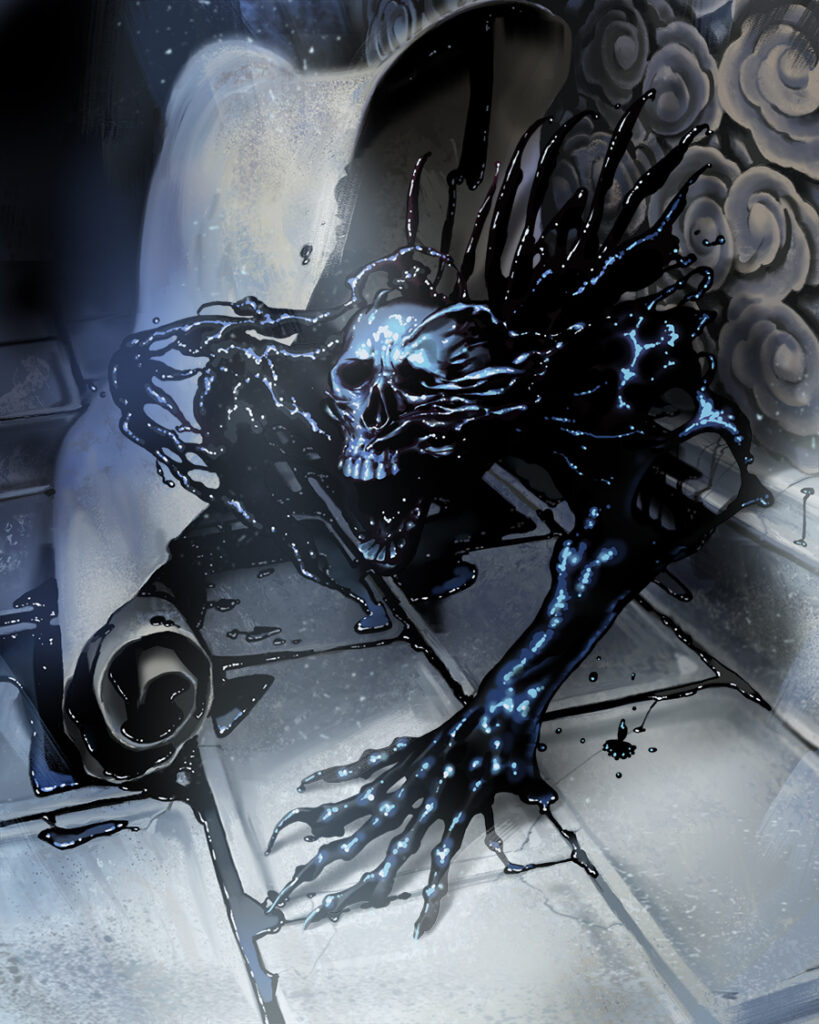
Welden Bringhurst
Tell the readers who you are, your professional background, how you got into the game space, other products you’ve worked on that you’d like to highlight, and any other interesting or key notes about you as a person.
Hi, I’m Welden Bringhurst. Growing up, gaming was a big part of how my family connected and spent time with each other. I particularly enjoyed playing new games and analyzing which parts worked well and which parts fell flat. This quickly developed into a passion for game design that I have nurtured ever since. My professional background is in Business Analytics. I am currently working on another upcoming RPG title and several standalone board games.
What is one of your favorite clans (major or minor)? What about that clan resonates with you?
If I had to choose a favorite clan, it would probably be the Crab Clan. I admire their unity and single-minded focus on protecting Rokugan from the horrors of the Shadowlands. In our lives, it is too easy to get caught up in the politics and intrigue of the day. While they are important, I find myself most happy when I isolate myself from them and focus on loving and serving the people around me.
What aspects of Tomb of Iuchiban did you work on? What were your goals when setting out to work on each of those parts?
I designed the Bloodspeaker class, Keeper of Names archetype, and worked with Lydia and Lex to create and balance NPC profiles, encounters, and several rooms in the tomb. Growing up I often got frustrated playing platforming or adventure games that required you to perform an obscure set of actions to progress. It was important to me that players never felt the same way about the Tomb. I spent a lot of time building alternate solutions for the different rooms to ensure no one gets completely stuck. That said, some of the largest rewards in the tomb will come from players thinking outside the box and using the tools and knowledge they acquired in other rooms to aid them in whatever challenge they are currently facing.
What aspects of Tomb of Iuchiban did you work on? What were your goals when setting out to work on each of What is your favorite part of what you worked on?
I was one of the main class designers in the Adventures in Rokugan core book, and it was a pleasure to return and work on the new character options in this supplement. The Bloodspeakers and Keeper of Names have interesting new mechanics and a wide variety of build paths. They were designed with the existing classes in mind, and their skills and abilities synergize with a variety of party compositions and strategies. I can’t wait to see how players utilize these new options.
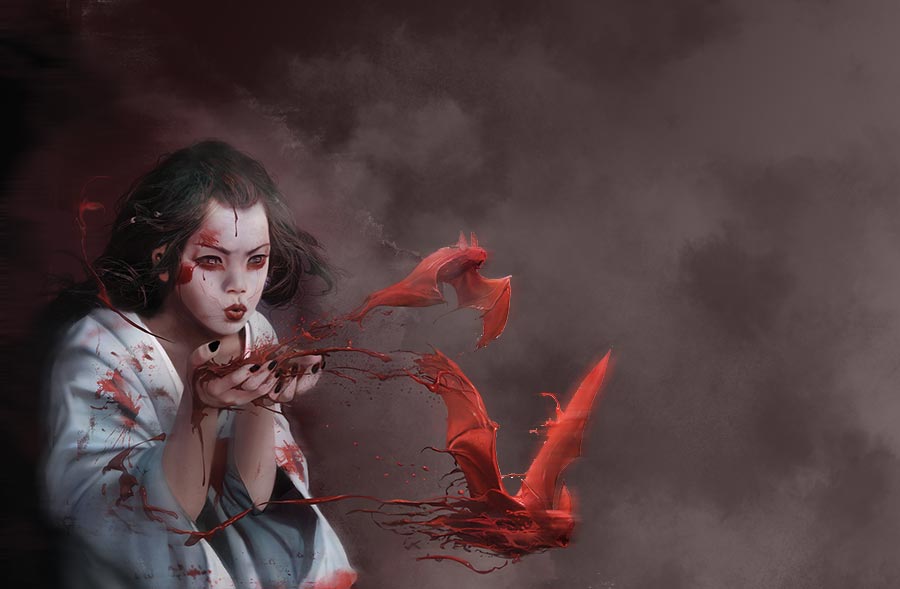
Back to Lex
I hope you enjoyed learning a bit more about some of the folks who made the Tomb of Iuchiban possible! We also owe a great deal of thanks to the Franchise Development Team, specifically Katrina Ostrander, for lending us their knowledge throughout the process of developing the book.
I’ll leave you with a few last notes about the book. First, it’s important to note that this product is certainly a horror module—it deals with pretty extreme themes and is definitely not for the faint of heart. We include some warnings at the start of the book about topics that we include, but before starting the game make sure you know your players and you’re sure they’re ready for a dark, dangerous, and deadly game. From horrifying monsters to truly dubious moral decisions, the trail ahead becomes bloodier with each uncertain step forward.
Tomb of Iuchiban is already available in your FLGS!
Download the Tomb of Iuchiban freebies visiting our “Resources” section




